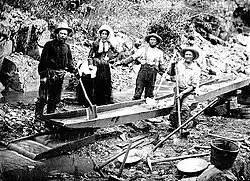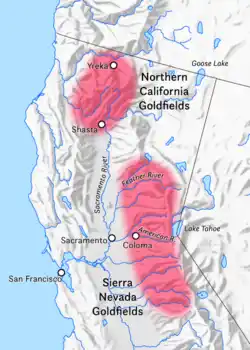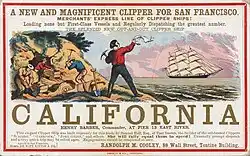
The California Gold Rush was an event that began early in 1848 when a large seam of gold was discovered at Sutter’s Mill by James W. Marshall in Coloma, in the US state of California. As word spread east to the core of the United States, hundreds of thousands of people began migrating westwards, either by land or by sailing around the Americas. The migration would continue well into the 1850s, establishing California as the core region of American settlement on the West Coast. More broadly, the California Gold Rush sparked the general expansion into the American West in the second half of the nineteenth century and was a major factor in the spread of the continental United States across the entire country to the Pacific Ocean.[1]
Chronology of eventsChronology of events

For centuries California had been nominally controlled by Spain as part of its vast empire in the Americas. Then, when Mexico attained its independence from Spain in the early nineteenth century, it along with the region corresponding with Nevada, Arizona, New Mexico, and Texas passed to the Mexican government. By then, some Spanish/Mexican settlement had begun to occur in California on the back of the missions established by Franciscans led by Junípero Serra there in the 1760s and 1770s. However, these were still relatively limited and the bulk of the population in the California region were still natives like the Yuman and Miwok Indians; that would all change with the advent of the gold rush.[2]
In 1846, the United States and Mexico went to war over control of the Texas region. The resulting American-Mexican War lasted two years and eventually resulted in Mexico ceding Texas, New Mexico, Arizona, Nevada, and California to the United States.[3] American adventurers were soon heading to California to make their fortune. One of these, James W. Marshall, struck gold at Sutter’s Mill in January 1848, even before the war with Mexico had ended. This, combined with news of previous Spanish/Mexican finds since the early 1840s, saw people begin to start streaming quickly from US states like Louisiana, Alabama, Georgia, Tennessee, and the Carolinas westwards. Many others though, came from even further afield on the East Coast, often traveling by sea instead of by land.[4] The California Gold Rush continued for many years to come, though the most intense period of migration occurred in the late 1840s and early 1850s. As it was underway, astonishing amounts of gold were being panned in rivers and pulled out of the ground in the region. It is estimated that some US$10 million was retrieved in 1949, followed by US$41 million in 1850, US$75 million in 1851 and US$81 million in 1852. Thereafter the rewards began to decline, though California remained a significant gold rush region until 1857. By the time it ended, California was already well-established as the pre-eminent center of settlement in the west of the United States, aided by the development of cities like San Francisco, Sacramento, Los Angeles, and San Diego. Some of these, such as Sacramento, emerged owing to their proximity to the Sierra Nevada Goldfields where Marshall had first struck gold back in 1848. By the time the gold rush ended, the advent of the railways had led to growing connections between the East Coast and the West Coast, while the discovery of oil in California in the 1870s allowed the state’s population to continue growing.[5]
Extent of migrationExtent of migration

The extent of the migration associated with the California Gold Rush was very considerable. In total, it is believed that some 300,000 people arrived in California during the first seven or eight years after 1848. The peak year was 1849, to such an extent that those who moved out to the West as part of the gold rush were often colloquially known as the ‘49ers. The routes taken varied. Some traveled overland on horses or with carriages, but others traveled by sea. Even amongst the latter, there were different routes used. Some, for instance, sailed south as far as Panama before traveling overland across the Isthmus of Panama (the canal would not be built for over half a century) and then sailing northwards to San Diego. Others sailed all the way around the Americas on clippers which headed out of ports like New York and Boston to Cape Horn on the southern tip of the continent, and then all the way back north to California. The demographics of the ‘49ers varied, with many being individuals who were arriving on the East Coast in large numbers from Ireland and other European countries in the late 1840s and early 1850s, though many others were established American settlers from states like Georgia and Tennessee who were seeking a new life out west as cotton prices declined in the context of the Industrial Revolution and their lives in the southern states became more difficult. Because of the rugged and harsh environment into which they were heading, often spending weeks or months pitched in tents near mines or rivers from which they would pan for gold, a considerably larger amount of those who moved out to California during the gold rush were men.[6]
Demographic impactDemographic impact
The demographic impact of the California Gold Rush is hard to precisely gauge. With nearly forty million inhabitants today, California is one of the most populous states in the United States. Yet this is primarily owing to many different waves of migration to the state which occurred at various times. For instance, the oil rush of the 1870s and 1880s brought newcomers, as did the railways, as indeed did the establishment of Hollywood and the film industry across the twentieth century. In this respect, it would be imprecise to suggest that the California Gold Rush had massively impacted the demographic landscape of the region, but what it did do is begin the process of westward migration in America. It was the ‘49ers who first settled in significant numbers in places like Sacramento and San Diego, and it was in the confidence that they could reach these places that many hundreds of thousands of more Americans snaked their way out west in the second half of the nineteenth century. This event had a profound impact on the Native American people of California, who were profoundly displaced by the arrival of the ‘49ers, to the extent that some scholars write of a California genocide occurring between the late 1840s and the 1870s. [7]
MyHeritage record collections from California in the 1800sMyHeritage record collections from California in the 1800s
See alsoSee also
Explore more about the California Gold RushExplore more about the California Gold Rush
- Historical records from California on MyHeritage
- Levi's: From a Quick Fix to the World's Bestselling Jeans from the MyHeritage Blog
References
- ↑ California Gold Rush. History Channel
- ↑ Senkewicz, Robert M. The Representation of Junípero Serra in California History. Santa Clara University, 2010.
- ↑ Mexican-American War. Naval History and Heritage Command
- ↑ California Gold Rush. Encyclopedia Britannica
- ↑ The California Gold Rush. American Experience
- ↑ The Forty Niners. Library of Congress
- ↑ Wolf, Jessica. Revealing the history of genocide against California’s Native Americans. UCLA Newsroom

